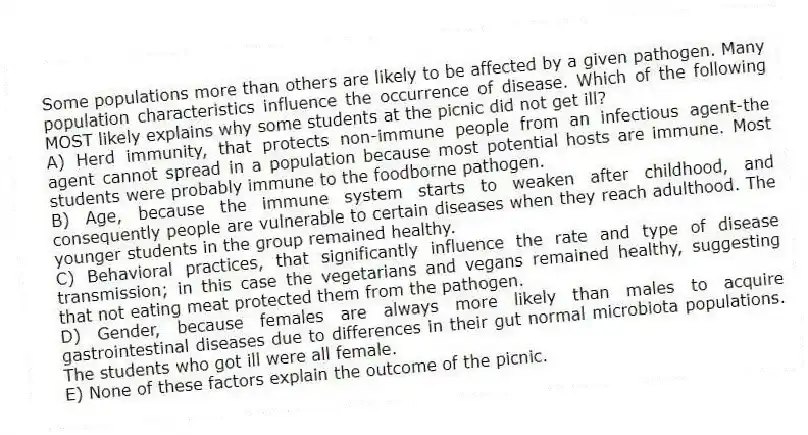
Some populations more than others are likely to be affected by a given pathogen. Many population characteristics influence the occurrence of disease. Which of the following MOST likely explains why some students at the picnic did not get ill?
A) Herd immunity, that protects non-immune people from an infectious agent-the agent cannot spread in a population because most potential hosts are immune. Most students were probably immune to the foodborne pathogen.
B) Age, because the immune system starts to weaken after childhood, and consequently people are vulnerable to certain diseases when they reach adulthood. The younger students in the group remained healthy.
C) Behavioral practices, that significantly influence the rate and type of disease transmission; in this case the vegetarians and vegans remained healthy, suggesting that not eating meat protected them from the pathogen.
D) Gender, because females are always more likely than males to acquire gastrointestinal diseases due to differences in their gut normal microbiota populations. The students who got ill were all female.
E) None of these factors explain the outcome of the picnic.
Correct Answer:
Verified
Q69: In 1918-1919, an influenza virus infected about
Q70: Explain the most likely reason why smallpox
Q71: Please select the False statement.
A) A common
Q72: The situation described in this case study
Q73: Explain how the incubation period can influence
Q75: Which of the following pathogens/diseases would be
Q76: Which pathogen is INCORRECTLY matched with a
Q77: Which of the following best defines an
Q78: The portal of entry of the pathogen
Q79: Please identify the CORRECT statement regarding basic
Unlock this Answer For Free Now!
View this answer and more for free by performing one of the following actions

Scan the QR code to install the App and get 2 free unlocks

Unlock quizzes for free by uploading documents